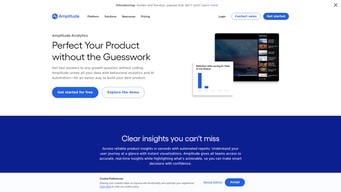

Unclaimed: Are are working at Amplitude Analytics ?
Amplitude Analytics Reviews & Product Details
Amplitude is an analytics tool designed to support businesses by helping them understand user behavior and giving them key insights that can help them improve their products. It offers tools such as behavior tracking, funnel analysis, as well as A/B testing that combines to help companies make data-driven decisions that optimize products and drive business growth.


| Capabilities |
|
|---|---|
| Segment |
|
| Deployment | Cloud / SaaS / Web-Based, Mobile Android, Mobile iPad, Mobile iPhone |
| Training | Documentation |
| Languages | English |


Compare Amplitude Analytics with other popular tools in the same category.

The endless options available to view data. i.e. chart types The features that allow you to easily organize the data. i.e. custom events, cohorts and event properties Templates are very usefull for bigenners
The pricing The dashboard UX should be a lot better, more features and better UI design
A. Transperancy and monitoring - Provieds full and accurate view of whats going on B. Desicion making - Allows me to avoide making desicion based on a feeling
the range of thing and reports you can you
that you can not connect it with a sheet and take some time to be really usefull
give me insights of what platforms are doing well
Oh, I really like how Amplitude Analytics provides in-depth insights into user behavior and helps me understand how people interact with my website or app. The real-time analytics and user-friendly interface make it easy for me to track key metrics and make data-driven decisions. Plus, the platform's flexibility allows me to create custom reports and analyze specific events, giving me a comprehensive view of user engagement. Overall, it's a powerful tool that greatly enhances my ability to optimize and improve the user experience.
Well, one thing that can be a bit challenging with Amplitude Analytics is the learning curve. It took me some time to fully grasp all the features and functionalities the platform offers. The abundance of options and settings can be overwhelming for beginners, and I wish there were more comprehensive tutorials or guides to make the onboarding process smoother. Additionally, while the basic features are user-friendly, some advanced functionalities may require a deeper understanding of analytics concepts. Sometimes, I find myself spending extra time figuring out how to set up more complex analyses or interpret certain data points. Lastly, the cost can be a consideration for smaller businesses or startups. The pricing structure may be a bit steep for those on a tight budget, especially as the scale of data and usage increases. It would be great to see more affordable plans or flexible options tailored to the needs of smaller businesses.
Amplitude Analytics is instrumental in solving several crucial problems related to understanding user behavior and improving the overall performance of my website or app. Here are a few key benefits: Insights into User Behavior: Amplitude helps me gain deep insights into how users interact with my platform. By tracking user journeys, identifying popular features, and analyzing drop-off points, I can make informed decisions to enhance the overall user experience. Data-Driven Decision-Making: With Amplitude, I can base my decisions on real-time, accurate data rather than relying on assumptions or gut feelings. This ensures that any changes or updates I make to the platform are backed by solid analytics, increasing the likelihood of success. Optimizing User Engagement: Understanding user engagement patterns allows me to optimize the content, features, and overall design of my website or app. This helps in retaining users, increasing session durations, and ultimately driving business goals. Personalization and Targeting: Amplitude enables me to create targeted marketing campaigns and personalized experiences. By analyzing user segments and behavior, I can tailor messages and promotions to specific audiences, improving the effectiveness of my marketing efforts. Identifying and Fixing Issues: The platform's ability to track events and user interactions helps me quickly identify any technical issues or bottlenecks within the application. This proactive approach allows for prompt issue resolution, ensuring a smooth user experience. In summary, Amplitude Analytics is a valuable tool for me as it provides the insights needed to refine and optimize my digital presence, ultimately leading to better user satisfaction and business success.
The ease of use once you understand the basics
As a new user is difficult to understand but once you get used to it its fine, maybe a better onboarding where its almost like "Amplitude university"
Lack of data and attribution
The best thing about amplitude is to create a number of different types of charts as per your need which actually helps us to track customer experience and improve our product and it is effortless to implement the charts.
There is no such downside but yeah chart types can be improved further.
By using amplitude, we are able to track our customer experience and journey on our product, and with those data we are improving our product to meet customer needs.
The analytics are comprehensive, but it's the rest of the package I have found distinctly beneficial. First, the Support documentation is well-organized and complete. 9 times out of 10 I can pretty easily find what I am looking for when I hit a wall. I self-taught Amplitude from just thier UI and some reliance on Support, starting from kind of zero user behavior analysis skills. Articles and blogs are especially helpful in giving me the context for my data quieries. They help me describe what I am doing and why to others. Last, I really need ot point out the in-app prompts that make it all work. Hover tooltips are extremely well done to keep me oriented, not going down a blind path. They really nail to in-app instrucive nature. (I oversee in-app instruction in my own software so I know what I am talking about with this).
There are several ways to get an analysis done, or best approaches. I miss having a CS person or ready-available guideperson who can get me over a hump to put me on the right path. I know what I want to know, but not always sure how to get it done. It's usually specific and I would benefit from a human being (NOT an AI) who can understand what I am trying to do and suggest a more streamlined course. Sometimes it is hard to know if I can really trust my results.
I can can data-driven statements to help influence our design and development work.
Great UI, great visuals, lots of charts for all kind of needs, reliable experimentation platform (this one I'm going to miss actually!), as a data-driven PM I can't be happier honestly.
Quotas don't really make sense for in-house analytic, leading to cases when PMs are forced to decide what events they absolutely need to track and when is nice-to-have but probably won't feed into current quota limits so out of question. And it might get very expensive very fast, justifying a move to another alternative solution, which there are plenty on the market.
For us it's solving all business needs, apart from actually storing event (we ue clickhouse for that). Experimentation, data analysis, trends, dashboards for each domain/surface/feature. Basically whole analytics is done in amplitude and it's a go-to place for insights into each step of user journeys.
Amplitude Analytics impresses with its user-friendly interface and powerful data analysis. It's a valuable tool for understanding user behavior and making data-driven decisions. Highly recommended!
While Amplitude is highly customizable, there are times when we wished for even more flexibility in creating custom events or tracking specific user actions. Also, We need more customizable Table visualisation.
In the banking sphere, optimizing conversion is crucial for web and mobile apps. With Amplitude we analyze user behaviour and metrics, which directly impacts revenue and business growth.
Prior to Amplitude, we were using 3 pieces of software for analytics, experimentation, and personalization. Amplitude rolls all three of these into one product, at a price that was noticeably cheaper. Amplitude also easily connects to our dataset and salesforce, which gives us much deeper analytics than front-end interactions (although it does that well) Amplitude integrations were easy to set up, we connected to Segment without issue. The charts are easy to create and I really like the anomaly and forecast charts. The emails I get that allow for root-cause analysis has been super useful. I check Amplitude daily. I've found generally speaking the responsiveness of support to be decent and the self-serve portal is very easy to navigate. Away from that, there's loads of official and unofficial YouTube videos that are easy to discover
One of the things I'd like to be able to see, which exists in Salesforce, is whether we're on track/on-target. Amplitude won't let you set KPIs and then report based on them. Being able to add them to a dashboard would be so useful to those who regularly check the software.
We use Amplitude to understand how prospects and customers navigate from PoC to success. We use this to create look-alike campaigns to drive better conversion. As Amplitude to connected to our SaaS, we are able to make better product decisions. We frequently make top-of-funnel decisions based off of website data and experiments powered by amplitude
-> Analytics: You can learn too much about your digital product with conversion drivers, user journey, or even a funnel chart. With a powerful data governance process providing a scalable Taxonomy for self-service usability inside the platform. With an important point: Export public links of our notebooks analyses. -> Implementation: Completely ease to use Ampli CLI -> Integrations: Insane PLUG AND PLAY Integrations. -> Frequency: Every single day. -> Amazing Support by Product Minds and Amplitude Team
It's really difficult to find something that I don't like inside Analytics, but nowadays the complexity of deep analyses like Personas. It is really difficult to expand for all teams.
-> Understanding why the users are dropping off the funnel. -> Understanding conversion drivers -> Propagating self-service insights, analyses and data for all my coleagues.

